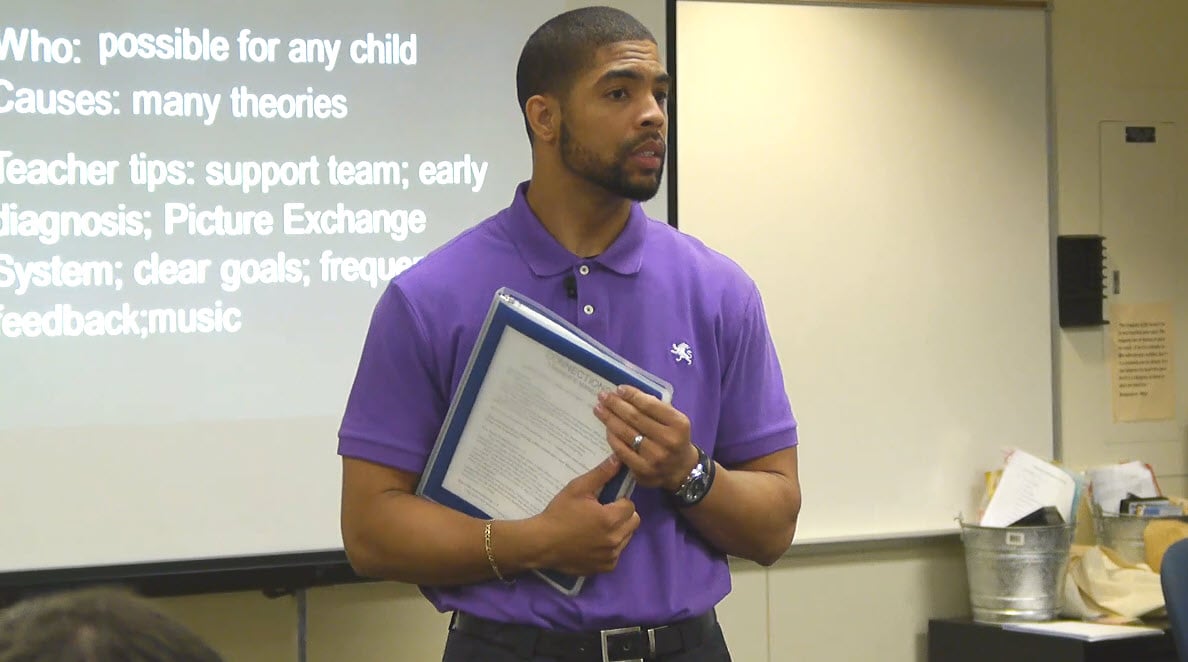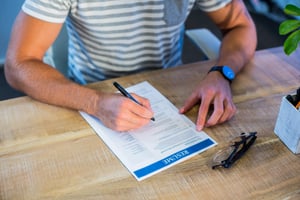



You’ve finished student teaching. Next step...Find a teaching job.
Your experience as a student teacher plays an important role in your work history as an educator. Student teaching is where you practice and learn the skills you will use in a full-time teaching job. It should be included on your resume, especially if you are changing careers and it is your only educator experience.
You may be asking yourself: What do I include in a resume to make sure I stand out among other applicants? Here’s what your resume should feature to grab the attention of the principal, and land you at the front of the class.
First thing’s first. No matter what type of job you’re seeking, all resumes should have these components. If you don’t have these in your resume, principals likely won’t give your resume a second look.
Contact information: Include your address, phone number and email. Make sure you use a professional-sounding email. An example would be one  that includes your name - not a nickname or favorite team, for example.
that includes your name - not a nickname or favorite team, for example.
An objective statement or resume summary statement: Which type of statement you include in the introduction is based on your work experience and qualifications. Read more about when you should use an objective versus a resume summary statement in our article, What Is A Resume Summary Statement?
Certifications: Include any certifications that are relevant to your teaching career, listed by bullet point. These include subject test(s) you have passed in Texas and alternative certification programs such as ECAP.
Education: In addition to the name of the elementary school, middle school or high school, include its location, your degree, year of degree and any relevant certifications or minors.
Targeted skills: Examples include classroom and general computer software, research skills, coaching and training.
The Work History section of your resume is where you will highlight your student teaching experience. How you present your teaching experience can make the difference between an average resume and an attention-grabbing resume.
In this experience section, include the school where you taught and dates. Principals also want to know the basics, such as how you:
Created and taught lessons
Learned a district’s grading software
Worked with families
Taught subject areas at certain grade levels
Other examples you may include that will enhance your resume are:
Participated in parent-teacher conferences
Developed and implemented individualized lesson plans for at-risk students
Distributed a weekly newsletter that communicated with families
Participated in IEP team meetings
Used positive behavior management strategies for classroom management
When describing your student teaching experience in your resume, use action verbs. Examples include “collaborated,” “created,” “developed,” and “motivated.” Using action verbs creates an impactful assessment of your work. Don’t be afraid to add some oomph as well by sharing statistics or figures that back up what you accomplished.
An example of a teaching experience may look like this:
Student Teacher, 3rd grade, Apple Springs Elementary, Apple Springs, Texas. September 2018 - January 2019.
Developed innovative lesson plans that motivated students and met state and federal curriculum requirements.
Participated in IEP team meetings to help individualize special education interventions for at-risk students.
Distributed weekly newsletter to 30 families that communicated classroom strategies, projects and lessons.
You may have participated in activities that will help set your resume apart as a student teacher. If you have had relevant positions - paid or unpaid - working with children, include them as well. Examples include:
Tutoring
Camp counselor
Sports coach
Volunteer work
Include a bullet point that describes your role, how you worked with students and what you accomplished in that position.
There are other headers you may consider in your resume, especially if you have limited teaching history. Ask yourself which experiences lend appeal to you as a candidate.
Here are some examples to consider:
Honors: Don’t overlook impressive honors. Examples include Dean’s List honors or earned teaching scholarships.
Professional development: Besides your student teaching experience, you may have attended conferences or workshops relevant to your teaching aspirations.
Professional memberships: Include any associations you belong to, especially if they are related to education. This demonstrates your commitment to your chosen field.
Study abroad experience: This can be valuable information to include in your resume. Examples include teaching or cultural experiences related to your content area.
Unique coursework: Consider any courses you have taken that could make you stand out to a principal. This may include foreign language courses, which could be helpful in a region where many ESL families live.
Time to hit “send”? Not quite yet. It’s time to conduct a thorough check and elevate your resume’s impact by making sure you’re incorporating these 10 key elements that truly make your student-teacher resume stand out:
Quantifiable Achievements: Emphasize measurable outcomes or achievements during your student teaching experience. For instance, mention specific improvements in students’ grades, increased participation rates or enhancements in standardized test scores resulting from your teaching methods.
Technology Integration: Highlight any innovative or creative ways you integrated technology into your teaching. Discuss how you utilized educational apps, online tools or interactive resources to enhance the learning experience for your students.
Differentiated Instruction Techniques: Explain how you tailored your teaching methods to accommodate diverse learning styles and abilities within your classroom. Showcase your ability to adapt lessons to meet individual student needs effectively.
Collaborative and Teamwork Skills: Describe instances where you collaborated with other teachers, staff members or parents to foster a supportive and inclusive learning environment. Emphasize your teamwork skills and ability to work in a collaborative educational setting.
Impact on Student Engagement: Discuss strategies you employed to actively engage students in the learning process. This might include innovative activities, interactive projects or hands-on learning experiences that captured students' interest and attention.
Professional References or Recommendations: Consider mentioning that you have references available upon request or provide recommendations from mentors, cooperating teachers or supervisors who can vouch for your teaching abilities and character.
Community Involvement and Outreach: If applicable, discuss any initiatives or programs you were involved in that connected the classroom to the broader community. This might include organizing community service projects, initiating partnerships with local organizations or leading extracurricular activities.
Continuous Learning and Growth: Showcase your commitment to ongoing professional development by mentioning any additional courses, workshops or certifications you pursued after your student teaching. Emphasize your eagerness to continue learning and growing as an educator.
Personalized Teaching Philosophy: Consider briefly articulating your teaching philosophy. This can help principals and hiring committees understand your approach to education and what drives your passion for teaching.
Tailoring the Resume to the School: Suggest customizing aspects of the resume to align with the specific school or district where you're applying. Highlight how your teaching style, experiences and skills resonate with the educational values or initiatives of the institution.
By incorporating these additional points, you'll provide a more comprehensive guide that showcases the diverse skills, experiences and attributes that can truly make a student teacher resume stand out in the competitive job market.
Crafting a well-written teacher cover letter can significantly complement your resume and enhance your chances of standing out as a candidate.
Some school districts may require a cover letter, while others may not. For that reason, some job applicants might question the necessity of a cover letter, especially when submitting an application online. However, a tailored and compelling cover letter can serve as your opportunity to showcase your passion, personality and suitability for the teaching role.
Here are some reasons why having a cover letter ready to go is a good idea:
While a resume is essential, a teacher cover letter provides an additional avenue to make a compelling case for why you are the ideal candidate. It allows you to showcase your personality, passion for teaching and alignment with the school's values, which can set you apart in a competitive job market.
In other words, a well-tailored cover letter can complement your resume by presenting a more holistic view of your qualifications and aspirations as an educator.
Your student teaching resume is an important marketing tool that can help you land the teaching job of your dreams. If you are changing careers to pursue your dream as a teacher, student teaching may be one of your only educator experiences.
That’s why including your time as a student teacher and any related experiences is important to give your resume a boost when competing against others vying for educator positions. For more tips on how to make the best first impression with your resume, read our article, 7 Teacher Resume Tips to Make You Stand Out.
Topics: Resume Help
Micah is the Director of Curriculum & Technology. He holds a Bachelor of Arts in British Literature, from the University of North Texas and a Master of Arts in Teaching, from Louisiana College. In his previous career, Micah served for 14 years as a banker and bank manager. For the majority of this period, Micah managed the Downtown Fort Worth location of Frost Bank. In 2005, Micah finally surrendered to his true calling to be an educator. After a brief, but fulfilling term teaching high school English at Flower Mound High School in Lewisville ISD, Micah went to work for the family business, training teachers.
7166 Baker Blvd., Suite B · Richland Hills, Texas 76118
Phone 817-284-7731 | Fax 817-284-3396
Login | Make Payment | ECAP Handbook | Privacy Policy | Pricing
Your Comments